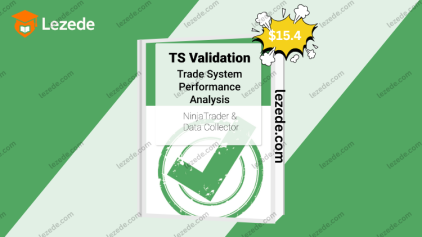Free Download Volatility Trading Strategies for Beginners By QuantInsti
Many traders and investors view volatility as a risk to avoid — but with the right knowledge, it can actually become an advantage. If you want to learn how to trade confidently during volatile conditions, this course is designed for you. You’ll explore four practical methods to measure volatility: ATR, standard deviation, VIX, and Beta. These tools will allow you to set adaptive stop-loss and profit targets, hedge risk with VIX products, and choose stocks more effectively for your portfolio.
LIVE TRADING
- Use ATR to track volatility, apply dynamic stop-losses, and compare results against fixed stop-loss strategies.
- Define and calculate the standard deviation of a stock, then integrate it into a trading approach.
- Understand Bollinger Bands, their phases, and design systems to spot and trade trends.
- Learn about the VIX, its unique features, and explore the available VIX derivatives.
- Apply portfolio hedging, build a selective long strategy with VIX, and test a VIX spread setup.
- Explore Beta, apply the CAPM model, and backtest portfolios based on beta-driven stock selection.
- Execute paper/live trades, evaluate strategy performance, and consolidate your skills in a capstone project.
SKILLS COVERED
Strategies
- ATR
- Bollinger Bands
- Breakout setups
- Portfolio hedging with VIX
- Low-beta and high-beta plays
Concepts & Trading
- Moving averages & volatility measures
- Volatility Index (VIX)
- True Range
- Beta & CAPM
- VIX-related instruments
Python
- Pandas
- Numpy
- Matplotlib
- TA-Lib
- Seaborn
LEARNING TRACK 1
This program belongs to the Learning Track: Algorithmic Trading for Beginners.
PREREQUISITES
To benefit from this course, you should know the basics of financial markets and key trading terms like long, short, stop-loss, and profit target. Prior experience with trading platforms is recommended, and while Python knowledge isn’t mandatory, it’s a valuable plus for implementing strategies.
SYLLABUS
Introduction
Learn the application and effectiveness of volatility based trading strategies. You will be guided through the course structure and the various concepts covered in this course. Also, you can explore the various features that are available to you on Quantra.
- Introduction 5m 11s
- Course Structure 10m
- Quantra Features and Guidance 4m 9s
Entry Signals
In this section, you will learn about the moving average crossover strategy. You will learn to generate entry signals using moving average crossover.
- Section Overview 3m 8s
- Moving Average Crossover 4m 17s
- Features of Moving Average 2m
- Calculate Moving Average 2m
- How to Use Jupyter Notebook? 1m 54s
- Determine the Entry Points 10m
- Getting Started 5m
- Entry Signals 2m
- Calculate SMA 5m
Fixed SL & TP
Exiting using fixed stop-loss and fixed take profit is the simplest way of exiting an open position. In this section, you will learn how to implement the same in python.
- Exit Using Fixed Stop-Loss and Take Profit 10m
- Calculate Fixed Stop-Loss 5m
- Calculate the Trading Cost 5m
ATR
- In this section, you will learn about a volatility based indicator called The Average True Range (ATR). You will learn to calculate the True Range and Average True Range to measure stock volatility.
- Measuring Volatility using ATR 6m 29s
- Days Range 2m
- Properties of True Range 2m
- Calculate True Range 2m
- ATR Indicator 2m
- Calculate ATR 2m
- The Magnitude of ATR 2m
- Additional Reading for ATR 10m
SL & TP using ATR
In this section, you will learn how ATR can be used to determine the exits. Calculating stop-loss and take profit prices will be explained with examples.
- ATR to Determine Exits 4m 44s
- Limitation of Fixed Percentage Approach 2m
- ATR Value 2m
- ATR for Exits 2m
- Possible Range 2m
- Benefits of Dynamic Exits 2m
- Determine Stop-loss 2m
- Reset Stop-loss 2m
- Exit Using ATR 10m
- Calculate ATR for a Stock 5m
- Dynamic Stop-Loss 5m
- Comparison Between Fixed and Dynamic Approaches 10m
- Limitations of ATR 10m
- Compare ATR Values 2m
- Volatility and Price Change 2m
- Compare Volatility 2m
- Additional Reading for SL & TP using ATR 10m
Live Trading on Blueshift
This section will walk you through the steps involved in taking your trading strategy live. You will learn about the backtesting and the live trading platform, Blueshift. You will learn about code structure, various functions used to create a strategy and finally, paper or live trade on Blueshift.
- Section Overview 2m 19s
- Live Trading Overview 2m
- Vectorised vs Event Driven 2m
- Process in Live Trading 2m
- Real-Time Data Source 2m
- Blueshift Code Structure 2m 57s
- Important API Methods 10m
- Schedule Strategy Logic 2m
- Fetch Historical Data 2m
- Place Orders 2m
- Backtest and Live Trade on Blueshift 4m 5s
- Additional Reading 10m
- Blueshift Data FAQs 10m
Live Trading Template
This section includes a template of a trading strategy that can be used on Blueshift. This live trading strategy template uses moving average crossover for entry signals and ATR for exit signals. You can tweak the code by changing securities or the strategy parameters. You can also analyse the strategy performance in more detail.
- Paper/Live Exit Using ATR 10m
- FAQs for Live Trading on Blueshift 5m
Measuring Volatility Using Standard Deviation
This section introduces you to the concept of standard deviation. You will learn to calculate standard deviation and use standard deviation to measure stock volatility.
- Standard Deviation 2m 41s
- Intuition of Standard Deviation 2m
- Comparing Standard Deviation 2m
- Measuring Volatility 2m
- Calculation of Standard Deviation 2m 5s
- Calculate Standard Deviation of a Stock 5m
- Standard Deviation Formula 2m
- Variables of Standard Deviation Formula 2m
- Mean and Standard Deviation 2m
- Additional Reading on Standard Deviation 10m
Applications of Standard Deviation In Trading
In this section, you will learn the applications of standard deviation in trading. Calculating trading range and deciding exit parameters using the volatility will be explained with examples.
- How to Use Standard Deviation In Trading? 3m 6s
- Standard Deviation of a Stock 2m
- Trade Parameters Using Standard Deviation 2m
- Volatility Based Stop Loss 2m
- Test on Volatility and Standard Deviation 14m
Bollinger Bands
This introduced you to the most used volatility-based trading indicator, Bollinger Bands. You will learn to calculate Bollinger Bands. You will also learn to interpret Bollinger Bands to study the price and volatility of an asset.
- Bollinger Bands Calculation 4m 44s
- Formulas of Bollinger Bands 10m
- Basics of Bollinger Bands 2m
- Moving Average 2m
- Definition of Bollinger Bands 2m
- Calculate Bollinger Bands of a Stock 5m
- Interpretation of Bollinger Bands 2m 55s
- Entry and Exit Conditions of Oversold Trading Strategy 10m
- Bollinger Bands Study 2m
- Elements of Bollinger Bands 2m
- Oversold Condition 2m
- Oversold Trading Strategy 10m
- Oversold Strategy Signals 5m
- Additional Reading on Bollinger Bands 10m
Bollinger Bands Phases
In this section, you will be introduced to the concept of Bollinger bandwidth. You will learn to study the volatility cycles using the Bollinger Band phases. All four types of Bollinger Band Phases are explained in detail to give you an intuitive understanding.
- Interpretation of Bollinger Bands Phases 5m 20s
- Formulas of Bollinger Bands Phases 10m
- Bollinger Squeeze 2m
- Bollinger Phases 2m
- Volatility Cycle 2m
- Additional Reading on Bollinger Bands Phases 10m
Breakout Strategy
In this section, you will understand how to create a trading strategy using Bollinger Band phases. You will learn the entry and exit conditions of the breakout trading strategy designed using the Bollinger Band Phases.
- Breakout Strategy Using Bollinger Phases 6m 54s
- Long Entry and Exit Rules of Breakout Strategy 10m
- Phase Transition 2m
- Long Breakout Entry Conditions 2m
- Volatility Transition 2m
- Breakout Strategy Implementation 10m
- BB Bandwidth 5m
- Entry Signals 5m
- Exit Signal 5m
- Additional Reading on Breakout Strategy 10m
- Breakout Strategy Blueshift Live/Paper Trading Template 10m
VIX
Introduction to VIX
- Volatility During Unexpected Events 2m
- Long Term Effect of Volatility 2m
- Volatility Based Trading 2m
- Hedge Index Futures 2m
- Position in VIX Decline 2m
- Types of Volatility 1m 38s
- Property of Implied Volatility 2m
- Interpretation of VIX 3m 39s
- Maximum Value of VIX 2m
- Interpretation of Implied Volatility 2m
- Daily Volatility Using VIX 2m
- VIX and Low Volatility 2m
- Annualised VIX 2m
- VIX Level Interpretation 2m
- Volatility in Different Time Periods Using VIX 2m
- Types of VIX 1m 47s
- Volatility Index and S&P500 2m
- Trade Gold VIX Futures 2m
- VIX and Eurozone Volatility Index 2m
- Webinar Snippet – Introduction to Volatility 8m 40s
- Webinar Snippet – Why Is VIX Called the Fear Index? 7m
More on VIX
- Calculation of VIX 5m 40s
- Option Premium During Uncertain Periods 2m
- Inclusion of Options Based on Time of Expiry 2m
- Exclusion of Options Based on Time of Expiry 2m
- Inclusion of Options Based on Moneyness 2m
- Type of Options in VIX 2m
- Inclusion of Options Based on Bids 2m
- Inclusion of Options Based on Consecutive Bids 2m
- Properties of VIX
- Correlation of VIX and S&P500 2m
- VIX Time Series 2m
- Impact of Positive News on VIX 2m
- VIX Derivatives
- Hedge on VIX Futures 2m
- Identification of VIX Derivatives 2m
- Relationship Between VIX ETNs and VIX Futures 2m
- Additional Reading 10m
Hedging Using VIX
In this section, you will understand the inverse relationship between VIX and S&P 500. You will learn about the concept of hedge ratio. Further, you will apply the concept of hedge ratio to create a hedging strategy using VIX ETF.
- Hedging With VIX ETF 2m 13s
- Fall in S&P 500 2m
- Hedging the Losses 2m
- Hedge Ratio 2m
- Hedge Ratio – Always a Fixed Value? 2m
- Determine Hedge Ratio 2m
- Portfolio Hedging Using VIX 10m
- Compute Strategy Parameters 5m
- Calculate Daily Strategy Returns of Combined Portfolio 5m
Selective Long on VIX
In this section, you will improvise on the previous strategy by going selective long on VIX. You will also discover different ways to select when to go long on VIX.
- Selective Long VIX Strategy 5m 12s
- Identify Best Performing Assets 2m
- Always Long on VIXY 2m
- VIXY Monthly Returns 2m
- Improve Strategy Performance 2m
- VIX Levels 2m
- Drawbacks of Fixed VIX Value 2m
- Capture Panic Dynamically 2m
- SMA for Entry 2m
- Exit Conditions 2m
- Available Cash In Selectively Long Strategy 2m
- Selectively Long Strategy Returns 2m
- Compare Selectively Long with S&P 500 2m
- Going Selectively Long on VIX 10m
- Generate Buying Signal 5m
- Selective Long on VIX Blueshift Live/Paper Trading Template 10m
VIX Spread
- VIX Spread Concept 2m 52s
- VIX Spread Strategy 10m
- FAQ 10m
- Test on Bollinger Bands and VIX 16m
Understanding Beta
In this section, you will understand the concept of beta and what it is used for. You will learn about systematic and unsystematic risk. You will also discover what type of risk is measured by beta and how beta values are interpreted.
Beta and Its Interpretation
- Additional Reading for Drawbacks of Beta 10m
- Identify the Type of Risk 2m
- Define Beta 2m
- Identify Beta Value 2m
- Interpretation of Beta – I 2m
- Interpretation of Beta – II 2m
- Match the Beta Value – I 2m
- Match the Beta Value – II 2m
- Select a Stock Based on Beta 2m
Calculating Beta
This section explains how to calculate beta using the linear regression model with the help of Python. You will learn about the elements of the regression equation. You will also understand how to get the beta coefficient from a linear regression model.
- Pre-reading 10m
- How to Calculate Beta
- Define the Variables 2m
- Describe the Element 2m
- Define the Slope of Line 2m
- Identify Approximate Beta 2m
- Identify the Linear Regression Equation 2m
- Identify the Beta Value 2m
- Identify Correlation 2m
- Identify Volatility 2m
- Identify the Relevance of Beta 2m
- Identify the Independent Variable 2m
- Calculate Beta With Python 10m
- Identify the Number of Trading Days 2m
- Add the Constant Term 5m
- Calculate Beta 5m
- Fetch the Values 5m
Betting Against Beta
In this section, you will learn about the premise of the “Betting Against Beta” strategy. It includes a simple explanation of the author’s hypothesis. It also includes the steps that are required to implement the strategy.
Application of Beta
- Describe the Use of CAPM 2m
- Define Risk-free Rate of Return 2m
- Define Market Risk Premium 2m
- Describe the Theory of CAPM 2m
- Calculate Expected Returns 2m
- Betting Against Beta 3m 35s
- Identify the Valuation 2m
- Define the BAB Strategy 2m
- Describe the Hypothesis 2m
- Define Alpha 2m
- Select a Stock to Buy 2m
Research on BAB
This section attempts to validate the author’s hypothesis of the “Betting Against Beta” or the BAB strategy. This is done by testing the strategy on the past data of S&P 500 stocks and checking if it works by analysing the past performance of these stocks.
Research on BAB
- Data for Calculating Beta 2m
- Describe Strategy Testing 2m
- Steps to Implement the BAB Strategy 2m
- Identify the Order of Ranking 2m
- Identify the Criteria of Bucket Creation 2m
- Research on BAB – I 10m
- Split the data into train & test 5m
- Calculate Beta for Multiple Stocks 5m
- Create Stock Buckets 5m
- Calculate Average Returns for Each Bucket 5m
- Research on BAB – II 10m
Backtesting BAB
This section will teach you how to backtest a modified strategy based on the research made on the BAB paper in the previous section. On this opportunity, you will go long on high beta stocks to check whether we can be profitable with them. Data will be provided from 2015 to 2022.
- BAB Backtesting – I 10m
- Identify the Function 2m
- Calculate the Returns of the Chosen High Beta Stocks 5m
- BAB Backtesting – II 10m
- Test on Beta 10m
Run Codes Locally on Your Machine
In this section, you will learn to install the Python environment on your local machine. You will also learn about some common problems while installing python and how to troubleshoot them.
- Python Installation Overview 2m 18s
- Flow Diagram 10m
- Install Anaconda on Windows 10m
- Install Anaconda on Mac 10m
- Know your Current Environment 2m
- Troubleshooting Anaconda Installation Problems 10m
- Creating a Python Environment 10m
- Changing Environments 2m
- Quantra Environment 2m
- Troubleshooting Tips for Setting Up Environment 10m
- How to Run Files in Downloadable Section? 10m
- Troubleshooting for Running Files in Downloadable Section 10m
Capstone Project
This section will help you to develop a breakout strategy learnt in the Bollinger Bands section in order to identify the top 5 stocks from the S&P 500 that perform well from 2010 to 2022.
- Capstone Project: Getting Started 10m
- Problem Statement 10m
- Frequently Asked Questions 10m
- Code Template and Data Files 2m
- Capstone Project Model Solution 10m
- Capstone Solution Downloadable 2m
Course Summary
In this section, we will summarise all the volatility trading concepts and strategies that you have learned throughout the course. By the end of this section, you will get an idea of what you can do next to further improve your trading skills.
- Summary 4m 49s
- Course Summary and Next Steps 10m
- Python Codes and Data 2m
ABOUT AUTHOR
QuantInsti®
QuantInsti is the world’s leading algorithmic and quantitative trading research & training institute with registered users in 190+ countries and territories. An initiative by founders of iRage, one of India’s top HFT firms, QuantInsti has been helping its users grow in this domain through its learning & financial applications based ecosystem for 10+ years.
WHY QUANTRA®?
- Gain more in less time
- Get taught by practitioners
- Learn at your own pace
- Get data & strategy models to practice on your own
REVIEWS
NIKHIL NAIK India
The Volatility trading strategies course has surely helped me monitor VIX in a better way. I really like the breakout strategy implementation shown using the Jupyter notebook referring to tradebook, event driven backtesting and trade analytics. I tried the coding exercises and I found them interesting. My overall learning experience with Quantra is great, which is why I have enrolled in multiple courses on the platform.











